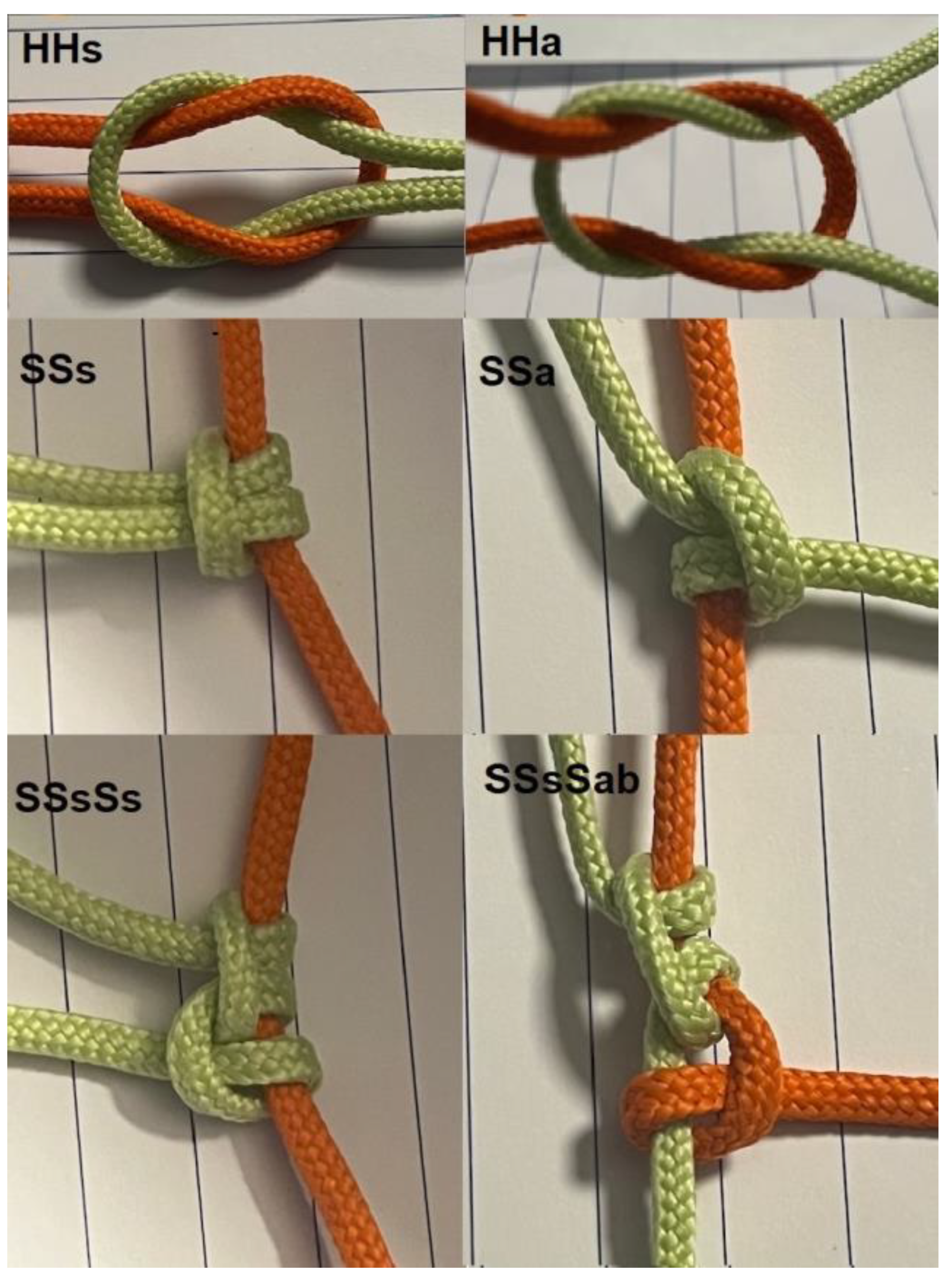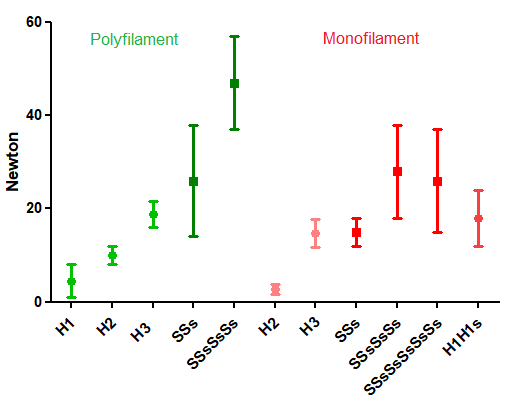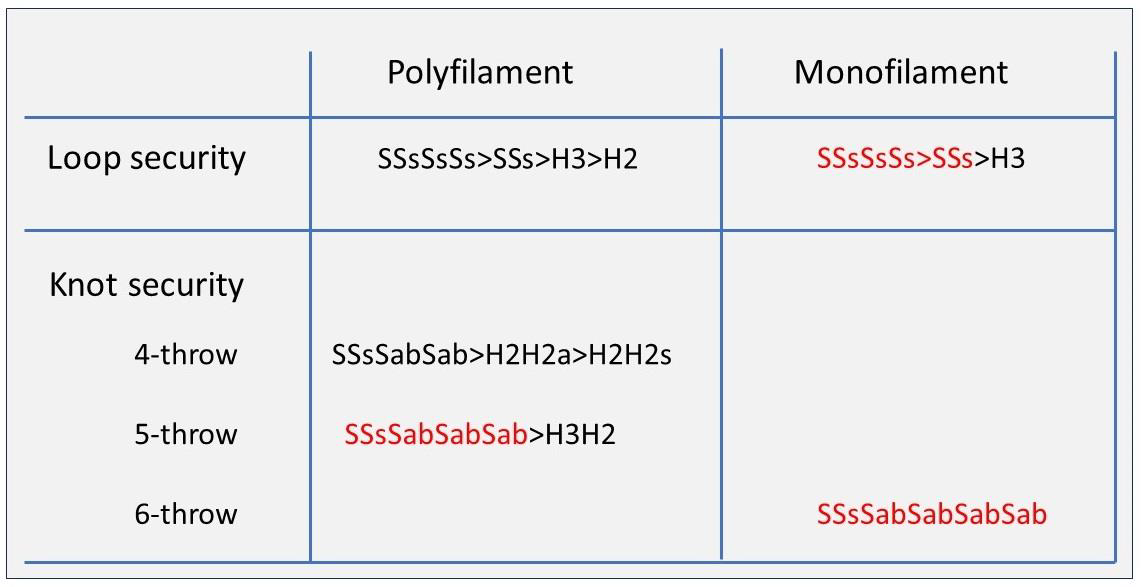
| Version | Summary | Created by | Modification | Content Size | Created at | Operation |
|---|---|---|---|---|---|---|
| 1 | Philippe R Koninckx | -- | 1433 | 2023-12-04 10:23:06 | | | |
| 2 | Jessie Wu | Meta information modification | 1433 | 2023-12-05 03:01:05 | | | | |
| 3 | Philippe R Koninckx | + 114 word(s) | 1547 | 2023-12-05 09:54:22 | | |
Video Upload Options
Surgical knots are sequences of half-knots (H) or half-hitches (S), defined by their number of throws, by an opposite or similar rotation compared with the previous one, and for half-hitches whether they are sliding (s) or blocking (b). Opposite rotation results in (more secure) symmetric (s) knots, similar rotation in asymmetric (a) knots, and changing the active and passive ends has the same effect as changing the rotation. Loop security is the force to keep tissue together after a first half-knot or sliding half-hitches. With polyfilament sutures, H2, H3, SSs, and SSsSsSs have a loop security of 10, 18, 28, and 48 Newton (N), respectively. With monofilament sutures, they are only 7, 16, 18, and 25 N. For knot security, half hitch sequences such as 2 sliding and 2 blocking half hitches are the future: the risk of destabilisation is less, and for monofilament sutures, they are mandatory.
1. Knots Are Sequences of Half-Knots and Half-Hitches

2. Nomenclature of Knots and Historical Perspective
| Knots | Throws | Knot Sequences | Rotation | Older Indication | New Indication |
|---|---|---|---|---|---|
| Half-knot | 1, 2, 3 | H1, H2, H3 | |||
| 2nd symmetric | alternate | H=H, 1=1 | H1H1s, H2H1s, H2H2s, H3H2s | ||
| 2nd asymmetric | similar | HxH, 1x1 | H1H1a, H2H1a, H2H2a, H3H2a | ||
| Secure half-knot sequences: H2H1sH1s, H2H2s or H2H2a, H3H2s or H3H2a | |||||
| Half-hitch | 1, 2 | S(1), (S2) | |||
| 2nd symmetric | alternate | ||||
| sliding | S=S, 1=1 | SSs(s) | |||
| blocking | S//S | SSsb | |||
| 2nd asymmetric | similar | ||||
| sliding | SxS, 1x1 | SSa(s) | |||
| blocking | S//xS | SSab | |||
| Secure half-hitch sequences: SSsSabSab | |||||
3. Testing and Definitions of Loop and Knot Security
4. Clinical recommendations
Loop security of monofilament sutures is less than for polyfilament sutures (Figure 2). Symmetric half hitches are preferred since loop security of 2 half hitches is higher than for a 3 throw half knot. Half hitches are also more versatile since a third or a fourth can be used if 2 are not sufficient.

Figure 2. Loop security of polyfilament (Vicryl) and monofilament (Monocryl) sutures. Mean and SDs are indicated.
The choice of knot combinations varies with the final knot security required. This is a clinical estimation since poorly known. For polyfilament sutures, correctly rotated half-hitch sequences are superior to 4 or 5 throw half-knot sequences. For monofilament sutures 6 half- hitch sequences, 2 sliding and 4 blocking, are mandatory (Figure 3)

Figure 3. Which knots to use in laparoscopical gynecologic surgery? Secure knots are indicated in black, more secure or preferred knot sequences knots in red.
References
- Chisnall, R.C. Analysing knots and ligatures: Tying principles, knot characteristics and structural changes. Forensic Sci. Int. 2020, 313, 110272.
- Romeo, A.; Rocha, C.L.; Fernandes, L.F.; Asencio, F.A.; Zomer, M.T.; Fujimoto, C.; Ussia, A.; Wattiez, A.; Koninckx, P.R.; Kondo, W. What is the Best Surgeon’s Knot? Evaluation of the Security of the Different Laparoscopic Knot Combinations. J. Minim. Invasive Gynecol. 2018, 25, 902–911.
- Romeo, A.; Fernandes, L.F.; Cervantes, G.V.; Botchorishvili, R.; Benedetto, C.; Adamyan, L.; Ussia, A.; Wattiez, A.; Kondo, W.; Koninckx, P.R. Which Knots Are Recommended in Laparoscopic Surgery and How to Avoid Insecure Knots. J. Minim. Invasive Gynecol. 2020, 27, 1395–1404.
- Schubert, D.C.; Unger, J.B.; Mukherjee, D.; Perrone, J.F. Mechanical performance of knots using braided and monofilament absorbable sutures. Am. J. Obstet. Gynecol. 2002, 187, 1438–1440; discussion 1441–1442.
- Van Leeuwen, N.; Trimbos, J.B. Strength of sliding knots in multifilament resorbable suture materials. Gynecol. Surg. 2012, 9, 433–437.
- Trimbos, J.B. Security of various knots commonly used in surgical practice. Obstet. Gynecol. 1984, 64, 274–280.
- Ishikawa, N.; Watanabe, G. Figure 4 Knot: Simple Tying Technique for Robotic and Endoscopic Sutures. Innovations 2017, 12, 152–153.
- Romeo, A.; Cipullo, I.; Kondo, W.; Benedetto, C.; Amro, B.; Ussia, A.; Wattiez, A.; Koninckx, P.R. The importance of rotation to teach secure half-hitch sequences in surgery. FVVOG, 2023; in press.
- Mackenzie, M.W. Laparoscopic intracorporeal cinch knots: Changing the square knot paradigm. J. Minim. Invasive Gynecol. 2012, 19, 225–235.
- Ivy, J.J.; Unger, J.B.; Hurt, J.; Mukherjee, D. The effect of number of throws on knot security with nonidentical sliding knots. Am. J. Obstet. Gynecol. 2004, 191, 1618–1620.
- Tera, H.; Aberg, C. Strength of knots in surgery in relation to type of knot, type of suture material and dimension of suture thread. Acta Chir. Scand. 1977, 143, 75–83.
- Amortegui, J.D.; Restrepo, H. Knot security in laparoscopic surgery. Surg. Endosc. 2002, 16, 1598–1602.
- Kondo, W.; Zomer, M.T.; Hayashi, R.M.; Fernandes, L.F.; Fujimoto, C.; Romeo, A. Different Blocking Sequences Performed by Laparoscopy. J. Minim. Invasive Gynecol. 2018, 25, 773.
- Tremolada, G.; Hazenfield, K.M.; Smeak, D.D. In vitro holding security of four friction knots of monofilament or multifilament suture used as a first throw for vascular ligation. Am. J. Vet. Res. 2020, 81, 821–826.
- Scott, J.F.; Ascha, M.; Pollard, W.; Bordeaux, J.S. A granny sliding knot for high-tension closures. J. Am. Acad. Dermatol. 2019, 80, e145–e146.
- Burrow, R.; Batchelor, D.; Cripps, P. Complications observed during and after ovariohysterectomy of 142 bitches at a veterinary teaching hospital. Vet. Rec. 2005, 157, 829–833.
- Sanders, R.E.; Kearney, C.M.; Buckley, C.T.; Jenner, F.; Brama, P.A. Knot Security of 5 Metric (USP 2) Sutures: Influence of Knotting Technique, Suture Material, and Incubation Time for 14 and 28 Days in Phosphate Buffered Saline and Inflamed Equine Peritoneal Fluid. Vet. Surg. 2015, 44, 723–730.




